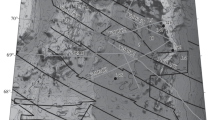Abstract
The central part of the northern Labrador Sea is a magnetic quiet zone, and is flanked by regions exhibiting well developed linear magnetic anomalies older than anomaly 24. The quiet zone dies out progressively to the south, where it becomes possible to correlate anomalies between adjacent profiles. A 45 degree change in spreading direction at anomaly 25 time was accompanied by a major jump in ridge position and orientation. As a consequence of this reorganisation, spreading in the northern Labrador Sea next occurred within a rift that was oriented at 45 degrees to the spreading direction, while to the south spreading occurred within in a rift that was orientated at 90 degrees to the spreading direction. Obliquity of spreading changed, between these limits, progressively along the ridge. The quiet zone may be present to the north because the oblique northern geometry resulted in a fragmented ridge composed of many small-offset transform faults joining many short spreading ridge segments. Each magnetic source block produced by magnetisation of sea floor at these small ridge segments will be surrounded by similar small blocks that have opposite polarity, so that none can be resolved at the sea surface. Supporting evidence comes from multi-channel seismic profiles across the Labrador Sea, which show that the basement is more textured within the quiet zone than outside, suggesting the presence of numerous small fracture zones in the quiet zone.
A magnetic quiet zone is present in the northern Greenland Sea between margins that are oblique to the spreading direction. In contrast, there are clear lineated magnetic patterns in adjacent areas to north and south where the margins are orthogonal to the spreading direction. This quiet zone may also be due to the geometry of spreading.
Similar content being viewed by others
References
Ballard, R. D. and VanAndel, T. H.: 1977, ‘Project FAMOUS: Operational Techniques and American Submersible Operations’, Geol. Soc. Amer. Bull. 88, 485–506.
Heirtzler, J. R. and Hayes, D. E.: 1967, ‘Magnetic Boundaries to the North Atlantic Ocean’, Science 157, 185–187.
Hinz, K., Schluter, H. U., Grant, A. C., Srivastava, S. P., Umpleby, D., and Woodside, J.: 1979, ‘Geophysical Transects of the Labrador Sea: Labrador to Southwest Greenland, Tectonophysics 59, 151–183.
Kristoffersen, Y. and Talwani, M.: 1977, ‘Extinct Triple Junction South of Greenland and the Tertiary Motion of Greenland Relative to North America’, Geol. Soc. Amer. Bull. 88, 1037–1049.
LePichon, P. R., Hyndman, R. D., and Pautot, G.: 1971, ‘Geophysical Study of the Opening of the Labrador Sea’, J. Geophys. Res. 76, 4724–4743.
Lonsdale, P.: 1977, ‘Structural Geomorphology of a Fast Spreading Rise Crest. The East Pacific Rise near 3 degrees, 25 minutes South’, Mar. Geophys. Res. 3, 251–393.
Poehls, K. A., Luyendyk, B. P., and Heirtzler, J. R.: 1973, ‘Magnetic Smooth Zones in the World's Oceans’, J. Geophys. Res. 78, 6985–6997.
Roots, W. D.: 1976, ‘Magnetic Smooth Zones and Slope Anomalies: A Mechanism to Explain Both’, Earth Planet. Sci. Lett. 31, 113–118.
Roots, W. D., Roots, S. R., and Jackson, H. R.: ‘Resolution Thresholds for Sea-Floor Magnetic Source Blocks, the Structural Evolution of the Sea Floor Next to Passive Continental Margins, and the Origin of Magnetic Quiet Zones’, submitted Tectonophysics (in press).
Srivastava, S. P.: 1978, ‘Evolution of the Labrador Sea and its Bearing on the Early Evolution of the North Atlantic’, Geophys. J. Roy. Astron. Soc. 52, 313–357.
Srivastava, S. P. and Tapscott, C. R.: 1984, ‘Plate Kinematics in the North Atlantic’, in B. E. Tucholke and P. R. Vogt, eds., Geology of North America: the western Atlantic Region: Geol. Soc. America, Boulder (in press).
Talwani, M. and Eldholm, O.: 1977, ‘Evolution of the Norwegian-Greenland Sea’, Geol. Soc. Amer. Bull. 88, 969–999.
Vogt, P. R., Anderson, C. N., Bracey, D. R., and Schneider, E. D.: 1970, North Atlantic Magnetic Smooth Zones’, J. Geophys. Res. 75, 3955–3967.
Vogt, P. R., Taylor, P. T., Kovacs, L. C., and Johnson, G. L.: 1979, ‘Detailed Aeromagnetic Investigation of the Arctic Basin’, J. Geophys. Res. 84, 1071–1089.
Vogt, P. R., Perry, R. K., Feden, R. H., Fleming, H. S., and Cherkis, N. Z.: 1981, ‘The Greenland-Norwegian Sea and Iceland Environment Geology and Geophysics’, in A. F. M.Nairn, M.Chirkin, and F. G.Stehli (eds.), The Ocean Basins and Margins, Vol. 5. Plenum, New York, pp. 493–598.
Author information
Authors and Affiliations
Rights and permissions
About this article
Cite this article
Roots, W.D., Srivastava, S.P. Origin of the marine magnetic quiet zones in the Labrador and Greenland Seas. Mar Geophys Res 6, 395–408 (1984). https://doi.org/10.1007/BF00286252
Accepted:
Issue Date:
DOI: https://doi.org/10.1007/BF00286252




